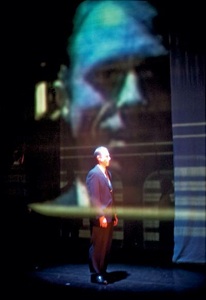This has been a pretty great theatre year so far and we’re only a month in. Nick Payne’s tremendous Constellations, about which I must write, is a thoughtful, precise, funny and exuberantly melancholy piece of work. Nancy Harris’s Our New Girl isn’t perfect but she’s got a really strong voice and keeps us guessing and switching. I loved 1927‘s Animals and Children Take to the Streets and now we have the wonderful thing that is The Trial of Ubu.
The evening falls into two parts. Almost as a curtain-raiser, we begin with a cut-down Ubu the King,
played as is traditional as a puppet show, in a new version by Simon
Stephens. It’s raucous and funny and brutal. It’s very familiar (this is
the Ubu we all know) and it’s expertly done and feels fresh and new.
But that’s about fifteen minutes of the performance. We then move onto The Trial of Ubu.
The Trial of Ubu
follows the proceedings of a war-crimes trial, with Ubu accused of
various crimes, asked to account for a mass grave, and so on. We get a
little glimpse of Ubu in his cell and the behaviour of the prosecutors.
The play is boring. It’s dull and
deliberately, thrilling so. The horror of the events described has been
filtered into judicial procedures; the affect has been stripped from
them. It’s a matter of evidence and testimony. It is the anti-Ubu. The
original play is all outrage and horror and
offence and grotesquerie; the events described are foolish, impossible,
not to be taken seriously. The Trial of Ubu has none of the outrage and
all of the taking-it-seriously. It’s quite brilliantly done. For one
thing, of course, by removing the affect from the performance, we are
forced to supply it as the audience. The baroque horrors of Ubu’s death
pit are chilling because of the normality with which they are described.
But Katie Mitchell has gone a step
further. Rather than stage the trial itself, we are watching a pair of
translators, simultaneously rendering the proceedings into English.
Their job is simply to transfer the semantic contents from one language
to another and they add yet another level of flatness, of jarring
disaffection to proceedings. The details of the trial also compete with
the detail of the translators: their clothes, their relationship, their
techniques, their own moods. Indeed, we feel that there is another story
being told here: they at times seem to be moved or horrified by what
they are translating, having to pass on the baton to the other because
of the strength of what they have heard; but also they seem to have some
kind of relationship themselves, which goes through some kind of crisis
towards the end of the performance. As a result, we experience a kind
of profound dislocation, the data about these atrocities at one end of
the communicative journey and the corresponding (or possibly
corresponding) emotions at the other end. At times, we fast-forward
through portions of the testimony and watch the two translators as if on
a video, their sitting positions and head movements adjusting abruptly.
We are caught - well, I was caught - between both enjoying the
rendering of that video experience and finding something emotionally
angular in their jerking, flinching movements, as if the air were full
of needles.
What this did for me was radically to defamiliarise Ubu. One of the most famous pieces of theatrical outrage, Ubu Roi has softened a bit. I loved the Graeae production in the 1990s, Jamie Beddard’s Ubu
a foul, spittle-flecked, roaring tyrant, a real grotesque who raised
all sorts of atavistic feelings in me about disability and bodily
control that made it an edgy night at Oval House that has stayed with me
for years. But that was an exceptions. David Greig’s version for Dundee
played BITE a few years ago and while I loved the pugnacious
translation, the production seemed a bit panto. It’s lost its power to
shock, for me, and the first fifteen minutes were the shocking version
that I knew I was comfortable with. But the second half brought
everything foul about the play into focus - so that the moment where a
screen slides away to show us Ubu in his cell, looking every inch the
puppet monster from the Théâtre de l’Oeuvre 110 years ago, was like
being introduced to Ratko Mladić at a dinner party.
A stunning start to the year.


![photo[1].jpg](https://images.squarespace-cdn.com/content/v1/513c543ce4b0abff73bc0a82/1362919072201-PZO854G4SEB794DVOEI8/photo%5B1%5D.jpg)
